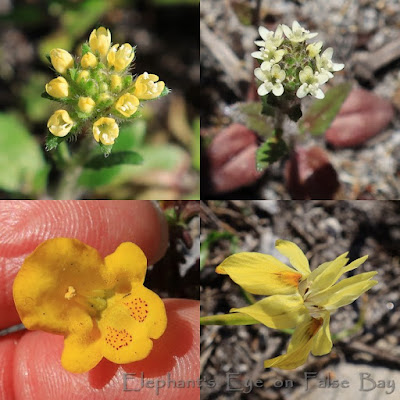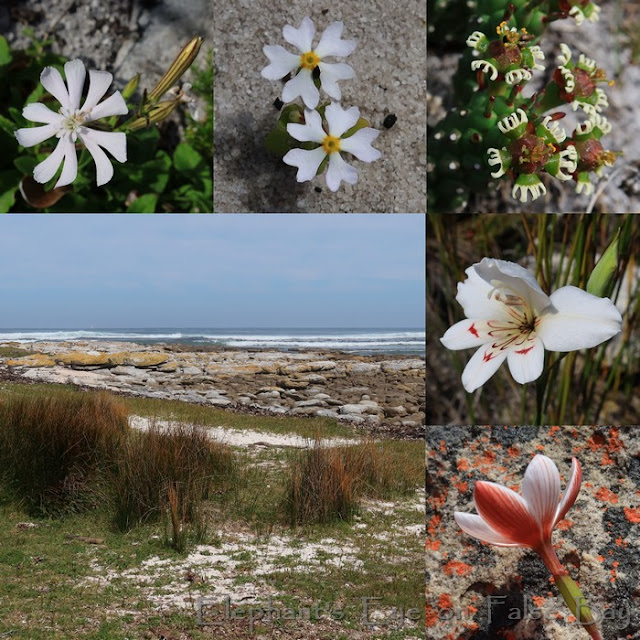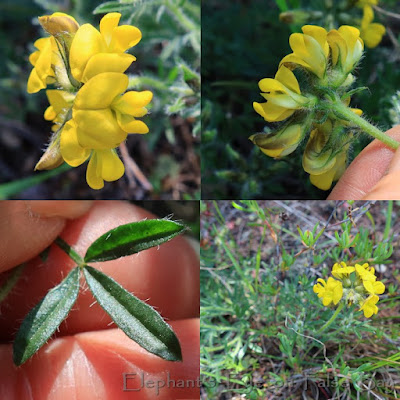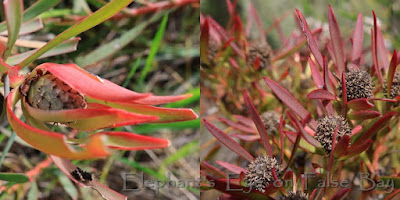September hikes to Silvermine Wetland, Trappieskop, Rondebosch Common, Gifkommetjie, and Myburghskloof
by Diana Studer
- gardening for biodiversity
in Cape Town, South Africa
Hiking among wildflowers
in the mountains
around Cape Town
This week our list runs to over one hundred species (but only 11 on my photos). I've been Fynbos Rambling for 5 years. In the first weeks my head exploded with ... ALL ... these ... new ... NAMES!! I carefully wrote down each plant we saw (we do restrict ourselves to flowering now, but it's still overwhelming) And I took photos of each one. First my list fell by the wayside, not enough hands to go round - and I rely on the archived list which is emailed to us later. Then I became more choosy about which plants were worth a few photos, for iNatting and my lifelist (618 Cape Peninsula species, four and a half thousand to go), or for help with tricksy IDs. Since 2 out of 5 of my readers are on cellphones, I will use less of the tiny pictures on my blog (the collages I love are postage stamps on mobile)
Back to September, starting at our Silvermine Wetland for Ferraria crispa blackspider lily. Helichrysum teretifolium showing the terete (rolled under margins) leaves.
 |
| Silvermine wetland for Ferraria crispa September |
Continuing up to Trappieskop (which we see from our house). Very tiny pair. Phyllopodium cordatum (Scrophulariaceae) lemon buds to white flowers, and Hemimeris sabulosa tipped to show the usually hidden dotted patches. Yellow Moraea gawleri has one long leaf.
 |
| Trappieskop September yellows |
Staying with tiny. Furry Holothrix villosa bud. Unusual here Nemesia barbata with lower lip in deepest blue. Lichen spiky Cladonia chlorophaea and riffled foliose Parmotrema.
 |
| Holothrix on Trappieskop in September |
Rondebosch Common for bulbs in splendour. In purples tall Babiana fragrans, lower Babiana ambigua. Lachenalia unifolia has zebra stripes around the leaf base. Vivid peacock eye for reestablished Moraea aristata. A peachy Moraea gawleri. Reminder to self = scaly bracts = Sparaxis grandiflora.
 |
| September bulbs on Rondebosch Common |
Gifkommetjie at Cape Point and yet a nother yellow daisy Oncosiphon sabulosus.
 |
| Oncosiphon sabulosus at Gifkommetjie September |
Silene undulata - African dream root is used for divination and traditional healing by amaXhosa. Little white sister for Zaluzianskya villosa. Most weird flowers for Euphorbia caput-medusae (named for the writhing head of snakes growth habit!) We walk down along the rocks to the shore, wind along, then climb up the boardwalk. Gladiolus debilis cream with yellow and burgundy calligraphy. Capturing the harmony between Geissorhiza ovata bud and lichen.
 |
| Flowers at Gifkommetjie in September |
Ending at Myburghskloof above Hout Bay. We walk up from Suikerbossie, very, slowly (toggle to Map) along the first bit of the path from the base of Judas Peak towards Myburghskloof. Walked up a little and found a new pea Lotononis involucrata - flowers clustered at the tip, soft leaves, low and creeping.
 |
| Lotononis involucrata Myburgskloof in September |
Chatting on the path, I was mesmerised by a 'bird' mousewalking in Colpoon compressum. Lots of lush red berries. And one very happy mouse devouring them!
 |
| Mouse eating Colpoon berries Myburgskloof in September |
Trying to learn more proteas. Leucadendron spissifolium with female and male cones.
 |
| Leucadendron spissifolium Myburgskloof in September |
Orchids showing off. Satyrium lupulinum we have only seen once before. Pterygodium catholicum usually in the soft yellow, but just two plants in salmon. Pink Ixia scillaris. Cream delicately edged with burgundy for Wurmbea spicata. Pauridia capensis here has spectacular peacock eyes in purple and turquoise!
 |
| September with orchids at Myburgskloof |
Our hikes are listed on my page.
I invite you to join us at Elephant's Eye on False Bay. Please subscribe as you prefer
via NEW non-Feedburner at Feedly,
or my Facebook blog page
Pictures by Diana Studer
of Elephant's Eye on False Bay
Teal blue text is my links.
To read comments if you are in a Reader,
first click thru to the blog)
Thanks for comments that add value. Your comment will not appear until I've read it. I welcome comments on posts from the last 2 months.
Google and Blogger comments uncooperative? Use Name / URL instead.

What is the white one with the blue center called?
ReplyDeleteTop one is Moraea aristata, bottom one is Pauridia capensis.
DeleteCapturing photos of 4500 more plants will surely keep you busy for a very looong time ;) My own Ferraria crispa seem to have died back in response to our drought and I miss them. I love the 2 Moraea in this post - they're gorgeous.
ReplyDeleteSo many interesting flowers in your part of the world!
ReplyDeleteI didn't realise there were African Wurmbeas as well. Our local one, Wurmbea dioica (common name Early Nancy), is flowering at the moment.
Ooh nice, mostly around Melbourne https://www.inaturalist.org/taxa/504086-Wurmbea-dioica/browse_photos
DeleteWow, that's incredible! I learn so much whenever I visit your blog. It's so inspirational and beautiful!
ReplyDeleteThis abundance of flowers gets me every time. Beautiful beautiful blooms.
ReplyDeleteAmalia
xo
So many wonderful plants, some of which I've never seen before!
ReplyDelete